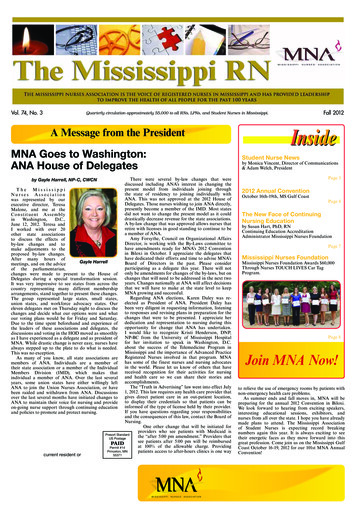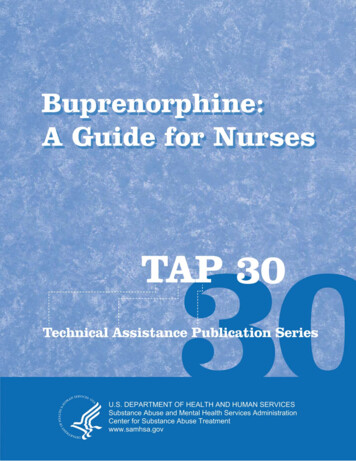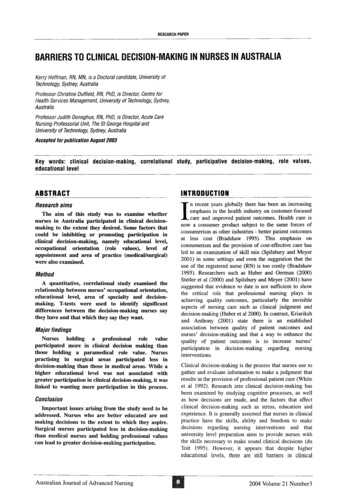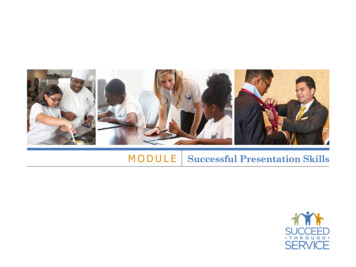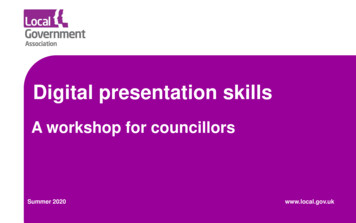
Transcription
Presentation Skillsfor NursesTeresa Knoop, MSN, RN, AOCN Assistant Director, Clinical OperationsClinical Trials Shared ResourceVanderbilt Ingram Cancer CenterNashville, TN1
DisclosuresNo conflicts to discloseObjectives Recognize a variety of ways that clinical information can bepresented. Identify guidelines to use when developing a clinical nursingpresentation. Identify skills necessary to deliver a dynamic and effectivepresentation.2
Presentations!!!“According to most studies, people's number one fear is publicspeaking. Number two is death. Death is number two. Does thatsound right? This means to the average person, if you go to a funeral,you’re better off in the casket than doing the eulogy”Jerry SeinfeldIntroduction Types of clinical information General guidelines for presenting clinical information Learning by example3
Types of Clinical InformationTypes of Clinical Information Clinical manifestations of disease Mechanism of action of treatment Adverse events related to treatment Management of clinical signs/symptoms/adverse events Patient education Case studies4
General Guidelines forPresenting Clinical InformationGeneral Guidelines forPresenting Clinical Information Prepare, prepare, prepare–––Several hours of prep for every one hour of presentationEvaluate the literature and ask yourself the questions you think the audience might askKnow your audience Define your purpose and organize your thoughts; be clear about your take-away message Practice, practice, practice Learn from your mistakesVollmann,K (2005) AACN Clinical Issues5
General Guidelines forPresenting Clinical Information Presentation components– Introduction PowerfulCaptures attentionTell them what you are going to tell them; convey purpose– Body Tell them– Conclusion Tell them what you told them (what message do you want them to take away?)Vollmann,K (2005) AACN Clinical IssuesGeneral Guidelines forPresenting Clinical Information Strategies for presenting clinical information–Present a professional image–Disclose any conflicts–Use slides to your advantage–Reference all material; even when taken from areas of public domain–Know your audience–Relate to the audienceVollmann,K (2005) AACN Clinical Issues6
General Guidelines forPresenting Clinical Information Strategies for presenting clinical information– Use analogies– Create mental images to help people remember– Use stories/real life experiences– Use humor– Ask for audience stories or experiencesVollmann,K (2005) AACN Clinical IssuesGeneral Guidelines forPresenting Clinical Information Handling question and answer sessions– Can cause anxiety due to fear of question you can’t answer or from fear of beingchallenged– Audience participation and questions are generally a complement to the speaker– Prepare yourself as much as possible for potential questions (if you ask yourselfthe question as you are preparing, be sure to look up the answer before thepresentation)Vollmann,K (2005) AACN Clinical Issues7
General Guidelines forPresenting Clinical Information Handling question and answer sessions– If a question seems hostile, briefly respond and offer to discuss after thepresentation– If you do not know the answer, be honest and offer to look it up later and email it– Don’t be afraid to be honest with the audience and do not try to bluff your waythough the answer– Bring the audience back to the key points of the presentationVollmann,K (2005) AACN Clinical IssuesLearning by example8
Clinical Manifestations of Disease9
Mechanism of Action10
Chimeric Antigen Receptor-T tment/research/car-t-cells#livingdrug11
Adverse Events Related to Treatment12
Checkpoint InhibitorsImmune Related Adverse Events Potentially serious/life-threatening GI (diarrhea colitis) Pulmonary (pneumonitis/interstitial lungdisease [ILD]) Endocrine (thyroid, adrenal, pituitary) Liver (hepatitis) Kidney (nephritis) Skin Neurokeytruda.com; opdivo.com; yervoy.com13
Nursing Management ofSigns/Symptoms/Adverse Events14
Patient EducationCheckpoint InhibitorsPatient/Caregiver Education Dermatologic Rash GI: Diarrhea or more bowel movements than usual Blood in stool or dark, tarry stools Stomach pain or tenderness Lung: New/worsening cough Chest pain Shortness of breathkeytruda.com; opdivo.com; yervoy.com15
Case Studies16
Presenting Case Studies Be concise and clear OK to read the case, but use inflection and further explanation Explain any unfamiliar concepts or word; don’t take familiarity for granted Know your audience Stick to the point of the case and don’t let the discussion get too far off track Use teachable moments17
Conclusion Types of clinical information– Recognize a variety of ways that clinical information can be presented. General guidelines– Identify guidelines to use when developing a clinical nursing presentation. Learning by example– Identify skills necessary to deliver a dynamic and effective presentation .18
?References Vollman K. AACN Enhancing Presentation Skills for the Advanced PracticeNurse: Strategies for Success. 16(1):67–77, JAN 200519
presentation. Identify skills necessary to deliver a dynamic and effective presentation. 3 Presentations!!! “According to most studies, people's number one fear is public speaking. Number two is death. Death is number two. Does that sound right?




